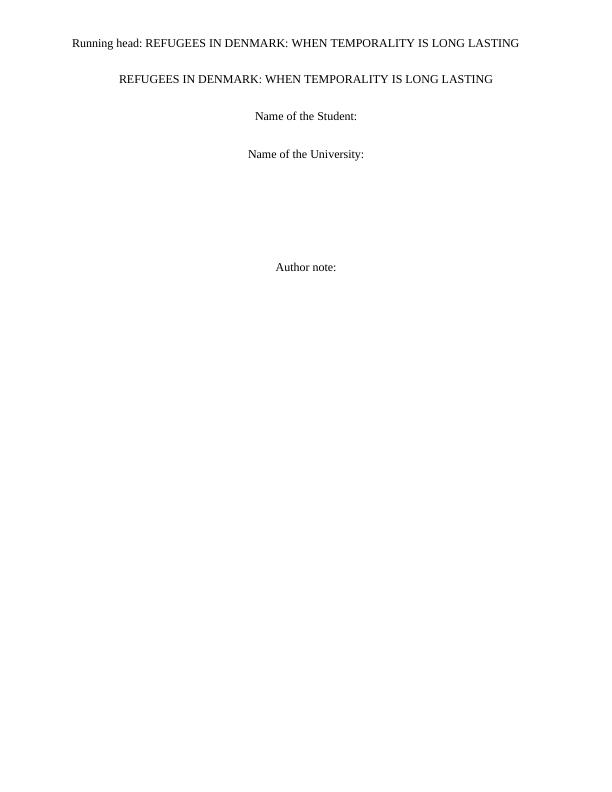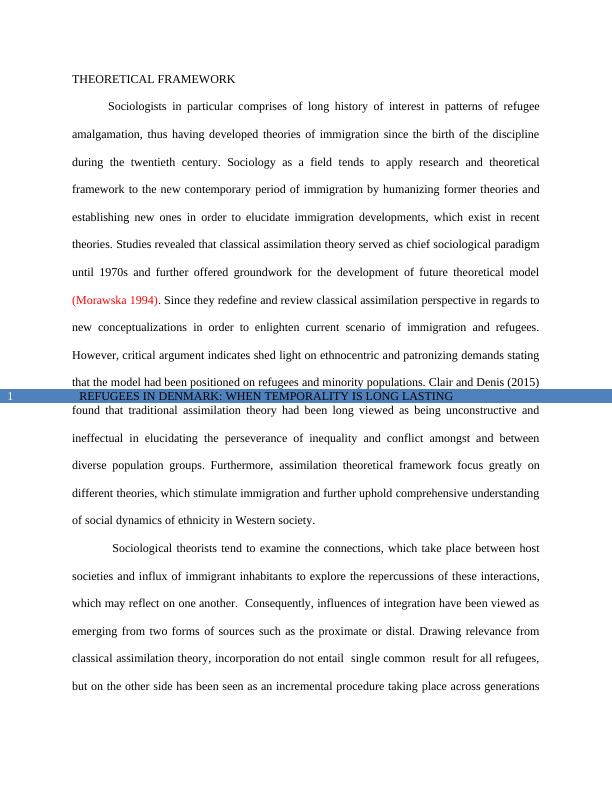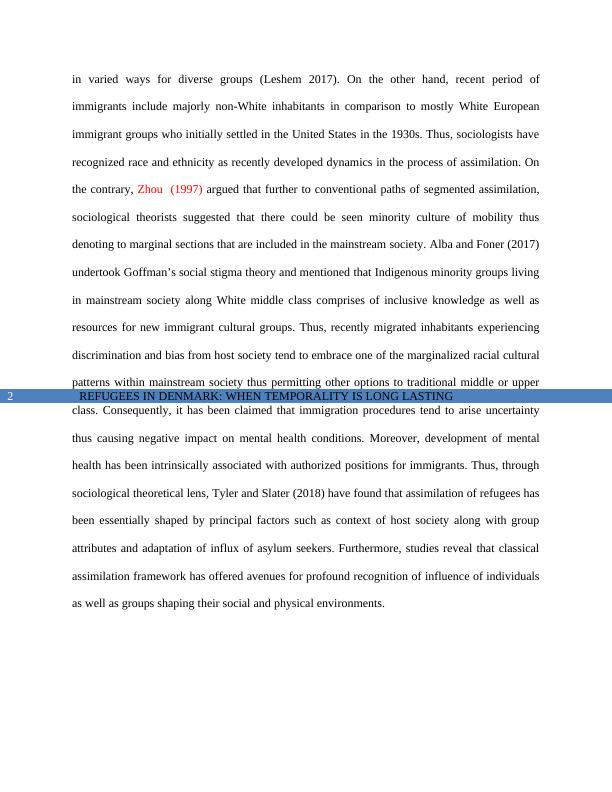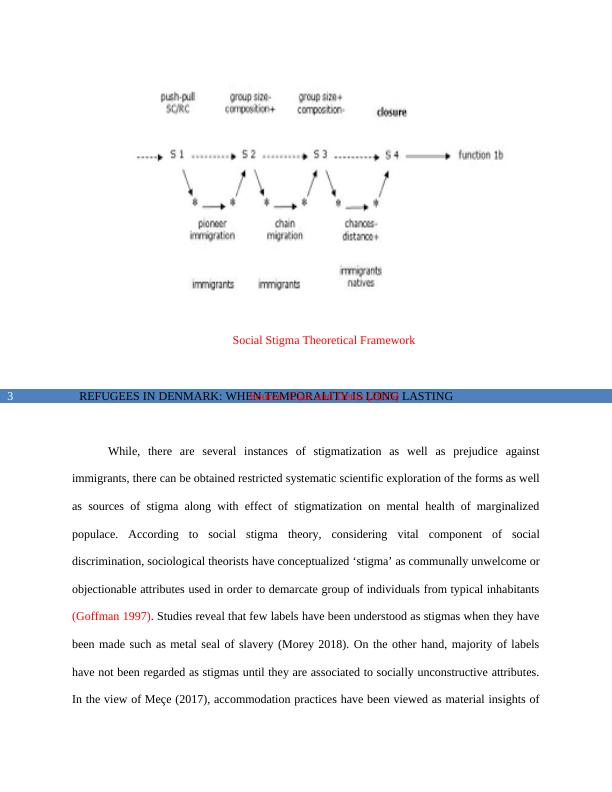Refugees in Denmark: When Temporality is Long Lasting
Added on 2022-09-22
15 Pages3624 Words18 Views
Running head: REFUGEES IN DENMARK: WHEN TEMPORALITY IS LONG LASTING
REFUGEES IN DENMARK: WHEN TEMPORALITY IS LONG LASTING
Name of the Student:
Name of the University:
Author note:
REFUGEES IN DENMARK: WHEN TEMPORALITY IS LONG LASTING
Name of the Student:
Name of the University:
Author note:

REFUGEES IN DENMARK: WHEN TEMPORALITY IS LONG LASTING1
THEORETICAL FRAMEWORK
Sociologists in particular comprises of long history of interest in patterns of refugee
amalgamation, thus having developed theories of immigration since the birth of the discipline
during the twentieth century. Sociology as a field tends to apply research and theoretical
framework to the new contemporary period of immigration by humanizing former theories and
establishing new ones in order to elucidate immigration developments, which exist in recent
theories. Studies revealed that classical assimilation theory served as chief sociological paradigm
until 1970s and further offered groundwork for the development of future theoretical model
(Morawska 1994). Since they redefine and review classical assimilation perspective in regards to
new conceptualizations in order to enlighten current scenario of immigration and refugees.
However, critical argument indicates shed light on ethnocentric and patronizing demands stating
that the model had been positioned on refugees and minority populations. Clair and Denis (2015)
found that traditional assimilation theory had been long viewed as being unconstructive and
ineffectual in elucidating the perseverance of inequality and conflict amongst and between
diverse population groups. Furthermore, assimilation theoretical framework focus greatly on
different theories, which stimulate immigration and further uphold comprehensive understanding
of social dynamics of ethnicity in Western society.
Sociological theorists tend to examine the connections, which take place between host
societies and influx of immigrant inhabitants to explore the repercussions of these interactions,
which may reflect on one another. Consequently, influences of integration have been viewed as
emerging from two forms of sources such as the proximate or distal. Drawing relevance from
classical assimilation theory, incorporation do not entail single common result for all refugees,
but on the other side has been seen as an incremental procedure taking place across generations
THEORETICAL FRAMEWORK
Sociologists in particular comprises of long history of interest in patterns of refugee
amalgamation, thus having developed theories of immigration since the birth of the discipline
during the twentieth century. Sociology as a field tends to apply research and theoretical
framework to the new contemporary period of immigration by humanizing former theories and
establishing new ones in order to elucidate immigration developments, which exist in recent
theories. Studies revealed that classical assimilation theory served as chief sociological paradigm
until 1970s and further offered groundwork for the development of future theoretical model
(Morawska 1994). Since they redefine and review classical assimilation perspective in regards to
new conceptualizations in order to enlighten current scenario of immigration and refugees.
However, critical argument indicates shed light on ethnocentric and patronizing demands stating
that the model had been positioned on refugees and minority populations. Clair and Denis (2015)
found that traditional assimilation theory had been long viewed as being unconstructive and
ineffectual in elucidating the perseverance of inequality and conflict amongst and between
diverse population groups. Furthermore, assimilation theoretical framework focus greatly on
different theories, which stimulate immigration and further uphold comprehensive understanding
of social dynamics of ethnicity in Western society.
Sociological theorists tend to examine the connections, which take place between host
societies and influx of immigrant inhabitants to explore the repercussions of these interactions,
which may reflect on one another. Consequently, influences of integration have been viewed as
emerging from two forms of sources such as the proximate or distal. Drawing relevance from
classical assimilation theory, incorporation do not entail single common result for all refugees,
but on the other side has been seen as an incremental procedure taking place across generations

REFUGEES IN DENMARK: WHEN TEMPORALITY IS LONG LASTING2
in varied ways for diverse groups (Leshem 2017). On the other hand, recent period of
immigrants include majorly non-White inhabitants in comparison to mostly White European
immigrant groups who initially settled in the United States in the 1930s. Thus, sociologists have
recognized race and ethnicity as recently developed dynamics in the process of assimilation. On
the contrary, Zhou (1997) argued that further to conventional paths of segmented assimilation,
sociological theorists suggested that there could be seen minority culture of mobility thus
denoting to marginal sections that are included in the mainstream society. Alba and Foner (2017)
undertook Goffman’s social stigma theory and mentioned that Indigenous minority groups living
in mainstream society along White middle class comprises of inclusive knowledge as well as
resources for new immigrant cultural groups. Thus, recently migrated inhabitants experiencing
discrimination and bias from host society tend to embrace one of the marginalized racial cultural
patterns within mainstream society thus permitting other options to traditional middle or upper
class. Consequently, it has been claimed that immigration procedures tend to arise uncertainty
thus causing negative impact on mental health conditions. Moreover, development of mental
health has been intrinsically associated with authorized positions for immigrants. Thus, through
sociological theoretical lens, Tyler and Slater (2018) have found that assimilation of refugees has
been essentially shaped by principal factors such as context of host society along with group
attributes and adaptation of influx of asylum seekers. Furthermore, studies reveal that classical
assimilation framework has offered avenues for profound recognition of influence of individuals
as well as groups shaping their social and physical environments.
in varied ways for diverse groups (Leshem 2017). On the other hand, recent period of
immigrants include majorly non-White inhabitants in comparison to mostly White European
immigrant groups who initially settled in the United States in the 1930s. Thus, sociologists have
recognized race and ethnicity as recently developed dynamics in the process of assimilation. On
the contrary, Zhou (1997) argued that further to conventional paths of segmented assimilation,
sociological theorists suggested that there could be seen minority culture of mobility thus
denoting to marginal sections that are included in the mainstream society. Alba and Foner (2017)
undertook Goffman’s social stigma theory and mentioned that Indigenous minority groups living
in mainstream society along White middle class comprises of inclusive knowledge as well as
resources for new immigrant cultural groups. Thus, recently migrated inhabitants experiencing
discrimination and bias from host society tend to embrace one of the marginalized racial cultural
patterns within mainstream society thus permitting other options to traditional middle or upper
class. Consequently, it has been claimed that immigration procedures tend to arise uncertainty
thus causing negative impact on mental health conditions. Moreover, development of mental
health has been intrinsically associated with authorized positions for immigrants. Thus, through
sociological theoretical lens, Tyler and Slater (2018) have found that assimilation of refugees has
been essentially shaped by principal factors such as context of host society along with group
attributes and adaptation of influx of asylum seekers. Furthermore, studies reveal that classical
assimilation framework has offered avenues for profound recognition of influence of individuals
as well as groups shaping their social and physical environments.

REFUGEES IN DENMARK: WHEN TEMPORALITY IS LONG LASTING3
Social Stigma Theoretical Framework
Source: Clair and Denis (2015)
While, there are several instances of stigmatization as well as prejudice against
immigrants, there can be obtained restricted systematic scientific exploration of the forms as well
as sources of stigma along with effect of stigmatization on mental health of marginalized
populace. According to social stigma theory, considering vital component of social
discrimination, sociological theorists have conceptualized ‘stigma’ as communally unwelcome or
objectionable attributes used in order to demarcate group of individuals from typical inhabitants
(Goffman 1997). Studies reveal that few labels have been understood as stigmas when they have
been made such as metal seal of slavery (Morey 2018). On the other hand, majority of labels
have not been regarded as stigmas until they are associated to socially unconstructive attributes.
In the view of Meçe (2017), accommodation practices have been viewed as material insights of
Social Stigma Theoretical Framework
Source: Clair and Denis (2015)
While, there are several instances of stigmatization as well as prejudice against
immigrants, there can be obtained restricted systematic scientific exploration of the forms as well
as sources of stigma along with effect of stigmatization on mental health of marginalized
populace. According to social stigma theory, considering vital component of social
discrimination, sociological theorists have conceptualized ‘stigma’ as communally unwelcome or
objectionable attributes used in order to demarcate group of individuals from typical inhabitants
(Goffman 1997). Studies reveal that few labels have been understood as stigmas when they have
been made such as metal seal of slavery (Morey 2018). On the other hand, majority of labels
have not been regarded as stigmas until they are associated to socially unconstructive attributes.
In the view of Meçe (2017), accommodation practices have been viewed as material insights of

End of preview
Want to access all the pages? Upload your documents or become a member.
